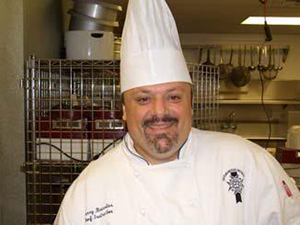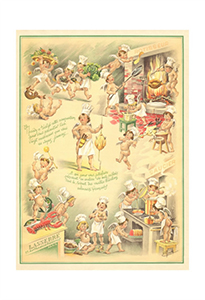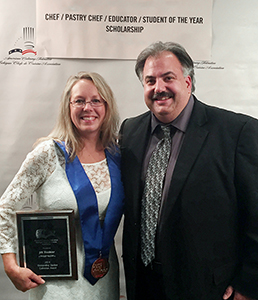Foodservice Educators Win Big at Culinary World Cup 2014
 AI Pittsburgh instructor Culp helped Culinary Team USA place third overall in Luxembourg, while U.S. chef-educators in individual competition represented their nation well.
AI Pittsburgh instructor Culp helped Culinary Team USA place third overall in Luxembourg, while U.S. chef-educators in individual competition represented their nation well.
Shawn Culp, CEC, department chair of culinary arts, baking/pastry and HRM at The Art Institute of Pittsburgh, Bridgeville, Pa., was part of the outstanding performance of ACF Culinary Team USA at the 12th-annual Villeroy & Boch Culinary World Cup 2014 in Luxembourg, Nov. 22-26. Garnering two gold medals and the highest score in the cold-food competition, the ACF team representing the United States placed third overall in one of the largest international culinary competitions in the world.
Culp (pictured) and five other chefs comprising ACF Culinary Team USA competed in the hot-food kitchen Nov. 22, where they prepared a three-course dinner for 110 people in six hours. On Nov. 25, the team competed in the cold-food portion of the competition, where they presented finger foods, a cold buffet platter, starters, a three-course vegetarian menu and a pastry-arts menu and showpiece.

 An award-winning pastry chef and talented baker and cake artist bring their seasonally inspired, artisanal confections to life at this Parisian-style Rhode Island bakery.
An award-winning pastry chef and talented baker and cake artist bring their seasonally inspired, artisanal confections to life at this Parisian-style Rhode Island bakery. ’Tis the season, says Chef Weiner, who among other things suggests a “Build a Gingerbread House” station to raise needed funds for programs.
’Tis the season, says Chef Weiner, who among other things suggests a “Build a Gingerbread House” station to raise needed funds for programs. In his final installment in a series on student assessment, Dr. Mayo says it is increasingly important to explain to students the criteria we use in grading. Not only does doing so make our jobs easier, but it is only fair to tell students ahead of time how they are going to be evaluated.
In his final installment in a series on student assessment, Dr. Mayo says it is increasingly important to explain to students the criteria we use in grading. Not only does doing so make our jobs easier, but it is only fair to tell students ahead of time how they are going to be evaluated. Employers seek graduates who follow directives, have a strong foundation of technical skills and enthusiastically respond, “Yes, Chef.” Yet knowing the “why” and “how to” is as important a skill as the actual process of completing a task.
Employers seek graduates who follow directives, have a strong foundation of technical skills and enthusiastically respond, “Yes, Chef.” Yet knowing the “why” and “how to” is as important a skill as the actual process of completing a task. A free classroom offer to teach students why menuing domestically raised fish and seafood is an important way to keep both customers and the bottom line happy.
A free classroom offer to teach students why menuing domestically raised fish and seafood is an important way to keep both customers and the bottom line happy. Le Cordon Bleu College of Culinary Arts in Los Angeles, Pasadena, Calif., is mourning the loss of a beloved educator. Chef instructor Larry Bressler, 50, and his wife, Denise, 64, passed away on Oct. 13, 2014. Bressler was a longtime instructor and friend to many at Le Cordon Bleu, known as a kind, fun-loving person with as much passion and zest for music as he had for food. He was also the general manager of Chefs Center, a commercial kitchen-rental space that helped launch many successful local businesses. From 1995 to 2003, Bressler was chef and owner of 50-seat Gerard’s, a French bistro in Riverside.
Le Cordon Bleu College of Culinary Arts in Los Angeles, Pasadena, Calif., is mourning the loss of a beloved educator. Chef instructor Larry Bressler, 50, and his wife, Denise, 64, passed away on Oct. 13, 2014. Bressler was a longtime instructor and friend to many at Le Cordon Bleu, known as a kind, fun-loving person with as much passion and zest for music as he had for food. He was also the general manager of Chefs Center, a commercial kitchen-rental space that helped launch many successful local businesses. From 1995 to 2003, Bressler was chef and owner of 50-seat Gerard’s, a French bistro in Riverside. Two chefs have joined the ranks of an elite group of Certified Master Chefs (CMC) following an eight-day exam from Oct. 26 to Nov. 2. The new Certified Master Chefs are:
Two chefs have joined the ranks of an elite group of Certified Master Chefs (CMC) following an eight-day exam from Oct. 26 to Nov. 2. The new Certified Master Chefs are: The Culinary Institute of America has partnered with Cool Culinaria to bring the CIA’s extensive collection of more than 30,000 menus to new audiences in the form of archival prints, notecards, coasters, mugs, tea towels, placemats and other products.
The Culinary Institute of America has partnered with Cool Culinaria to bring the CIA’s extensive collection of more than 30,000 menus to new audiences in the form of archival prints, notecards, coasters, mugs, tea towels, placemats and other products. A student and an instructor from Baker College of Port Huron Culinary Institute of Michigan (CIM) have each received a major award from the Michigan Chefs de Cuisine Association (MCCA), a chapter of the American Culinary Federation (ACF) serving the southeastern part of the state.
A student and an instructor from Baker College of Port Huron Culinary Institute of Michigan (CIM) have each received a major award from the Michigan Chefs de Cuisine Association (MCCA), a chapter of the American Culinary Federation (ACF) serving the southeastern part of the state.